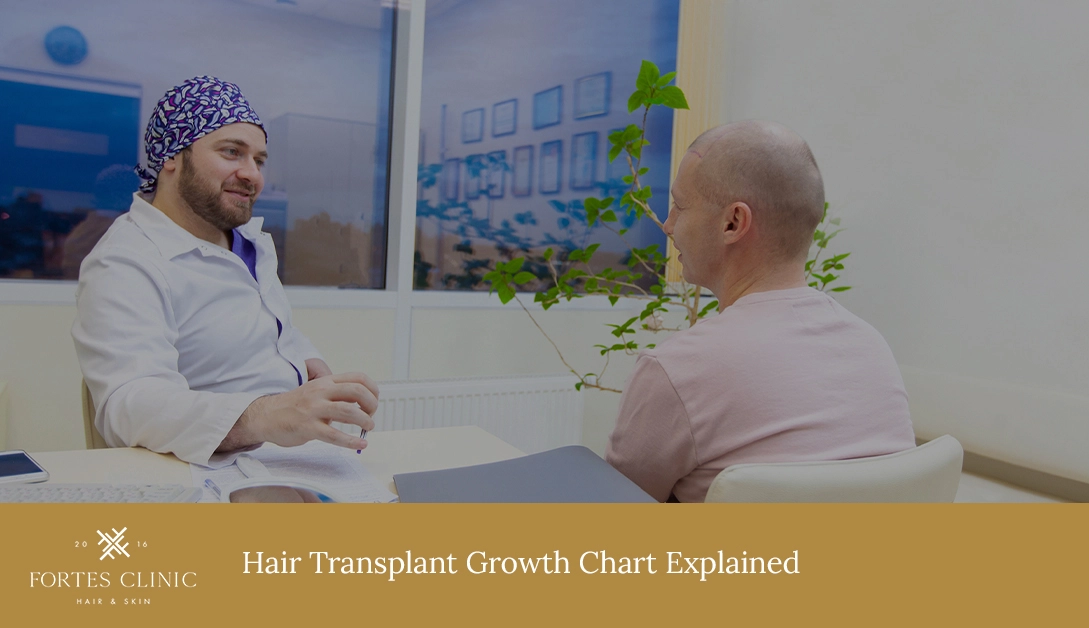Introduction
Hair transplantation is a sophisticated surgical technique designed to combat baldness by moving hair follicles from a dense area, the donor site, to a bald or thinning area, the recipient site. Primarily employed to address male pattern baldness, this procedure is gaining traction among those looking to restore not only their hairline but also their confidence. In this article, we delve deep into the growth phases following a hair transplant, explained through a detailed hair transplant growth chart, providing insights into what patients can expect during their recovery and hair growth journey.
Understanding Hair Transplants
What is a Hair Transplant?
A hair transplant is a surgical procedure that involves the extraction of hair follicles from a part of the body, known as the donor site, to a balding part of the body known as the recipient site. It offers a long-term solution to hair loss by transplanting new hair that will grow naturally. This procedure not only enhances the aesthetic appearance but also is pivotal in boosting the psychological well-being of the individual.
Types of Hair Transplant Techniques
FUE (Follicular Unit Extraction)
In FUE hair transplants, each follicular unit is individually taken directly from the scalp without a strip of tissue being removed. This technique reduces scarring and allows for a faster recovery, making it increasingly popular among patients who prefer less invasive procedures.
FUT (Follicular Unit Transplantation)
During FUT hair transplants, a strip of tissue containing multiple follicular units is removed from the donor area. The strip is then dissected into individual follicular units under a microscope before being implanted into the recipient area. While FUT can be more invasive and involves a longer recovery time, it typically allows for a greater number of grafts to be transplanted in a single session.
The Hair Transplant Growth Timeline
Initial Recovery Phase
The initial weeks following a hair transplant are crucial for the healing process. Patients may notice redness, swelling, and a tight sensation around the transplanted area, with tiny scabs forming around each graft. It is important during this phase to follow post-operative care instructions meticulously to ensure optimal healing and hair growth.
Early Growth Phase
Between three to six months post-transplant, patients will begin to see new hair strands emerging from the transplanted follicles. This hair will initially be quite fine and may grow unevenly; however, this is a normal part of the process, and the hair will gradually thicken over time.
Mature Growth Phase
From six months to one year, the new hair will start to mature and thicken, becoming more similar in texture and colour to the surrounding hair. This phase is where the most dramatic changes are observed, as the new hair fully integrates with the existing hair.
Long-Term Results
By the end of the first year, the full results of the transplant are typically visible. The transplanted hair will have matured and will continue to grow naturally throughout the life of the patient. Subsequent changes are more about hair quality and density improvements rather than new growth.
Factors Affecting Hair Transplant Growth
Genetic Factors
The genetic predisposition of the patient plays a crucial role in the nature of the hair growth post-transplant. Factors such as the density, colour, and texture of the hair are largely determined by genetics.
Lifestyle Factors
Diet and Nutrition
A nutritious diet rich in vitamins, minerals, and proteins can significantly impact the health and strength of newly transplanted hair. Nutrients such as vitamin C, vitamin D, zinc, and omega-3 fatty acids are particularly important for aiding hair growth and strengthening hair follicles.
Stress and Health
Stress can adversely affect the body’s healing capacity and the ability of hair follicles to regenerate. Managing stress through techniques such as yoga, meditation, or regular exercise can positively influence hair growth.
Post-Operative Care
Adhering to the surgeon’s post-operative care instructions is vital for promoting hair growth and preventing complications. This includes gentle hair washing, avoiding strenuous activities, and avoiding direct sunlight on the scalp for extended periods.
Hair Transplant Growth Chart Details
Reading and Interpreting Hair Transplant Growth Charts
A hair transplant growth chart is an essential tool for setting expectations. It typically shows the percentage of hair growth expected at various intervals post-operation, providing patients with a timeline for their recovery and hair growth.
Month-by-Month Growth Visualisation
Month-by-month visual aids help illustrate the gradual changes in hair density and quality, giving patients a visual representation of the stages of hair development and what to expect during each phase.
Case Studies with Visual Aids
Incorporating case studies and before-and-after photos provides real-life examples of hair transplant successes, offering new patients confidence and setting realistic expectations for their own outcomes.
Managing Expectations and Patient Satisfaction
Realistic Outcomes vs. Advertising Claims
It is crucial for patients to understand the difference between realistic outcomes and the often idealised images presented in advertisements. Setting realistic expectations can lead to higher satisfaction rates among patients.
Patient Testimonials and Case Outcomes
Sharing testimonials and detailed case studies from previous patients can help prospective clients better understand the process and outcomes, which enhances trust and satisfaction.
Common Questions About Hair Transplant Growth Charts
Why Does Hair Fall Out After a Transplant?
It is common for the transplanted hair to shed within the first few weeks post-transplant. This phenomenon, known as shock loss, is temporary and makes way for new hair growth.
How Fast Will Hair Grow Back?
After the initial shedding phase, hair typically grows at an average rate of 1 to 1.5 cm per month. However, the rate can vary based on individual health and genetic factors.
Can Growth Speed be Enhanced?
While genetic factors largely determine the rate of hair growth, adhering to good scalp care practices and maintaining a healthy lifestyle can aid in achieving the best possible outcomes.
Ready to start your journey? Book your appointment today or contact us for more information.



